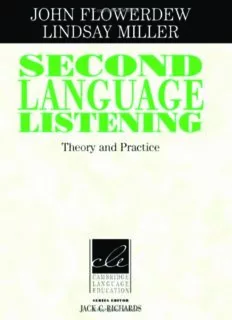Table Of ContentP1:JZP
0521781353agg.xml CY347/Flowerdew 0521781353 April7,2005 18:39
Second Language Listening: Theory and Practice
i
P1:JZP
0521781353agg.xml CY347/Flowerdew 0521781353 April7,2005 18:39
CAMBRIDGE LANGUAGE EDUCATION
SeriesEditor:JackC.Richards
Inthisseries:
AgendasforSecondLanguageLiteracybySandraLeeMcKay
ReflectiveTeachinginSecondLanguageClassroomsbyJackC.
RichardsandCharlesLockhart
EducatingSecondLanguageChildren:TheWholeChild,theWhole
Curriculum,theWholeCommunityeditedbyFredGenesee
UnderstandingCommunicationinSecondLanguageClassroomsby
KarenE.Johnson
TheSelf-DirectedTeacher:ManagingtheLearningProcessbyDavid
NunanandClariceLamb
FunctionalEnglishGrammar:AnIntroductionforSecondLanguage
TeachersbyGrahamLock
TeachersasCourseDeveloperseditedbyKathleenGraves
Classroom-BasedEvaluationinSecondLanguageEducationbyFred
GeneseeandJohnA.Upshur
FromReadertoReadingTeacher:IssuesandStrategiesforSecond
LanguageClassroomsbyJoAnnAebersoldandMaryLeeField
ExtensiveReadingintheSecondLanguageClassroombyRichardR.
DayandJulianBamford
LanguageTeachingAwareness:AGuidetoExploringBeliefsand
PracticesbyJerryG.GebhardandRobertOprandy
VocabularyinSecondLanguageTeachingbyNorbertSchmitt
CurriculumDevelopmentinLanguageTeachingbyJackC.Richards
Teachers’NarrativeInquiryasProfessionalDevelopmentbyKarenE.
JohnsonandPaulaR.Golombek
APracticuminTESOL:ProfessionalDevelopmentThroughTeaching
PracticebyGrahamCrookes
SecondLanguageWritingbyKenHyland
SecondLanguageListening:TheoryandPracticebyJohnFlowerdew
andLindsayMiller
ii
P1:JZP
0521781353agg.xml CY347/Flowerdew 0521781353 April7,2005 18:39
Second Language
Listening
Theory and Practice
John Flowerdew
CityUniversityofHongKong
Lindsay Miller
CityUniversityofHongKong
iii
P1:JZP
0521781353agg.xml CY347/Flowerdew 0521781353 April7,2005 18:39
CAMBRIDGEUNIVERSITYPRESS
Cambridge,NewYork,Melbourne,Madrid,CapeTown,Singapore,Sa˜oPaulo
CambridgeUniversityPress
40West20thStreet,NewYork,NY10011-4211,USA
www.cambridge.org
Informationonthistitle:www.cambridge.org/9780521781350
(cid:1)C JohnFlowerdewandLindsayMiller2005
Thisbookisincopyright.Subjecttostatutoryexception
andtotheprovisionsofrelevantcollectivelicensingagreements,
noreproductionofanypartmaytakeplacewithout
thewrittenpermissionofCambridgeUniversityPress.
Firstpublished2005
PrintedintheUnitedStatesofAmerica
AcatalogrecordforthisbookisavailablefromtheBritishLibrary.
LibraryofCongressCataloginginPublicationData
Flowerdew,John,1951–
Secondlanguagelistening:theoryandpractice/JohnFlowerdew,LindsayMiller.
p. cm.–(Cambridgelanguageeducation)
Includesbibliographicalreferencesandindex.
ISBN0-521-78135-3–ISBN0-521-78647-9(pbk.)
1.Languageandlanguages–Studyandteaching. 2.Listening–Studyandteaching.
I.Miller,Lindsay II.Title. III.Series.
P53.47.F58 2005
418(cid:2).0071–dc22 2003066738
ISBN-13 978-0-521-78135-0hardback
ISBN-10 0-521-78135-3hardback
ISBN-13 978-0-521-78647-8paperback
ISBN-10 0-521-78647-9paperback
iv
P1:JZP
0521781353agg.xml CY347/Flowerdew 0521781353 April7,2005 18:39
Contents
Serieseditor’spreface ix
Preface xi
Acknowledgments xiv
Part I HISTORICAL BACKGROUND 1
1 ApproachestoLanguageTeachingandtheRoleofListening 3
Introduction 3
TheGrammar-TranslationApproach 4
TheDirect-MethodApproach 5
TheGrammarApproach 6
TheAudio-LingualApproach 8
TheDiscrete-ItemApproach 10
TheCommunicativeApproach 12
TheTask-BasedApproach 14
TheLearner-StrategyApproach 16
TheIntegratedApproach 18
Conclusion 19
Discussion 20
2 ModelsofListening 21
Introduction 21
ListeningDevelopmentintheFirstLanguage 21
SpeechRecognitionandShort-andLong-TermMemory 23
ModelsoftheListeningProcess 24
SecondLanguageListeners 27
Conclusion 28
Discussion 29
v
P1:JZP
0521781353agg.xml CY347/Flowerdew 0521781353 April7,2005 18:39
vi Contents
3 TypesofMeaningforListening 30
Introduction 30
TypesofMeaning 30
Conclusion 46
Discussion 46
4 TheNatureofSpokenLanguage 47
Introduction 47
SpeechVersusWriting 48
ConversationalListening 52
Conclusion 59
Discussion 59
Appendix 59
5 LearningStylesandListeningStrategies 62
Introduction 62
GeneralLearningStyles 62
LearningStrategies 65
EffectiveandIneffectiveListeningStrategies 69
ListeningStrategiesintheClassroom 72
AStrategy-BasedApproachtoTeachingListening 72
Conclusion 80
Discussion 82
Part II A PEDAGOGICAL MODEL AND ITS APPLICATION 83
6 APedagogicalModelforSecondLanguageListening 85
Introduction 85
DimensionsofListening 87
AListeningDimensionsEvaluationChecklist 96
Conclusion 97
Discussion 97
7 MaterialsandthePedagogicalModelforListening 98
Introduction 98
Beginners 98
Low-Intermediate 103
Intermediate 106
P1:JZP
0521781353agg.xml CY347/Flowerdew 0521781353 April7,2005 18:39
Contents vii
Advanced 111
PreparingandPilotingListeningComprehensionMaterials 115
AnExampleofSpeciallyPreparedListeningMaterial 117
Conclusion 123
Discussion 123
8 CaseStudiesandtheirRelationtothePedagogicalModel 124
Introduction 124
CaseStudy1–YoungLearners 125
CaseStudy2–UsingTechnologytoImproveListening 129
CaseStudy3–AcademicListening 137
CaseStudy4–Self-AccessLanguageLearning 148
CaseStudy5–AnIntensiveLanguageCourse 155
Conclusion 162
Part III KEY ISSUES IN TEACHING AND TESTING 163
9 DevelopingListeningSkillsthroughTechnology 165
Introduction 165
Radio 165
Audiotapes 167
LanguageLaboratory 171
Video 172
Computer-AssistedLanguageLearning 178
Conclusion 182
Discussion 183
10 TheRoleofQuestionsintheTeachingofListening 184
Introduction 184
ModelsforIntegratingQuestionswhileTeachingListening 184
QuestionTypes 186
QuestionsandthePedagogicalModel 194
Conclusion 196
Discussion 196
11 TestingListening 198
Introduction 198
WhattoTest 202
P1:JZP
0521781353agg.xml CY347/Flowerdew 0521781353 April7,2005 18:39
viii Contents
HowtoTest 203
WhattoMeasure 206
HowtoAssessListening 208
Conclusion 209
Discussion 209
Appendix:ConcludingQuestionsforReflection 211
References 213
Index 221
P1:JZP
0521781353agg.xml CY347/Flowerdew 0521781353 April7,2005 18:39
Series editor’s preface
AcquiringgoodlisteningandspeakingskillsinEnglishisthemainconcern
ofmanysecondandforeignlanguagelearners,andtoday’sEnglishteacher
needstobewellversedincurrentapproachestotheteachingoftheaural/oral
skills.Secondlanguagelistening,relativelyignoredformanyyearswithin
applied linguistics, has today come into its own. Although still somewhat
neglected in second language acquisition research, listening now plays a
morecentralroleinlanguageteaching.Universityentranceexams,school
leaving tests, and other examinations have begun to include a listening
component,anacknowledgmentthatlisteningabilityisanimportantaspect
ofsecondlanguageproficiency.
Thenatureoflisteningcomprehensionisalsonowbetterunderstood.Ear-
lierviewsoflisteningsawitasthemasteryofdiscreteskillsormicroskills,
whichformedthefocusofteachingandtesting.Askillsapproachfocused
on such things as discriminating sounds in words (especially phonemic
contrasts), deducing the meaning of unfamiliar words, predicting content,
differentiatingbetweenfactandopinion,andnotingcontradictions,inade-
quateinformation,andambiguities.
Thechangedstatus oflisteninginrecentyearswaspartlypromptedby
Krashen’semphasisontheroleofcomprehensionandcomprehensiblein-
put in triggering language development. In the 1980s and 1990s, applied
linguists also began to borrow new theoretical models of comprehension
from the field of cognitive psychology. It was from this source that the
distinction between bottom-up processing and top-down processing was
derived–adistinctionthatledtoanawarenessoftheimportanceofback-
ground knowledge and schema in comprehension. Listeners were viewed
asactivelyinvolvedinconstructingmeaningbasedonexpectations,infer-
ences, intentions, prior knowledge, and selective processing of the input.
Listeningcametobeviewedasaninterpretiveprocess.Atthesametime,the
fieldsofconversationanalysisanddiscourseanalysiswererevealingagreat
dealabouttheorganizationofspokendiscourse,leadingtoarealizationthat
written texts read aloud could not provide a suitable basis for developing
theabilitiesneededtoprocessreal-timeauthenticdiscourse.Authenticityin
ix
Description:This book combines up-to-date listening theory with case studies of actual pedagogical practice. The paperback edition combines up-to-date listening theory with case studies of actual pedagogical practice. As an essential part of communicative competence, listening is a skill, which deserves equal t

